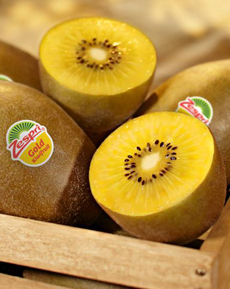PRODUCT: SunGold Golden Kiwi Fruit
 Kiwi: It’s not just green. Photo courtesy Zespri. |
In the late 1970s, New Zealand kiwifruit growers began experimenting with the breeding of a golden kiwifruit (in the U.S., we call it “kiwi” for short). Seeds were imported from China, where a female plant was chosen for its yellow flesh and excellent flavor, and was crossed with a male plant proven to produce large, succulent fruit. In 1992 one offspring plant from the breeding stock was selected and nurtured, resulting in the golden-fleshed berry* now known as Zespri® SunGold Kiwifruit. It is available at supermarkets nationwide from June through October. Zespri spent 10 years developing the SunGold variety through natural crossbreeding methods. SunGold is sweeter than a green kiwi, and tastes like a cross between a mango and a strawberry, with just a hint of tanginess. Like regular kiwi, it offers healthy ammounts of vitamins C and E, potassium. Its sunny yellow sweetness boosts the nutrition and color on your plate. Try it: |
|
|
Golden kiwifruit is usually ready to eat when you buy it. It should feel slightly soft to the touch, like a ripe peach or avocado. Once ripe, should be stored in the refrigerator. Green kiwifruit may be a bit firm when you buy it, and will usually ripen at in three to five days at room temperature. The firmer the fruit, the more tart it will taste. To speed up the ripening process, place kiwis (or any fruit) in a closed paper bag on the counter with an apple or banana. Fruits like apples and bananas produce natural ethylene gas, which accelerates ripening. By the same token, any ripe fruit should be stored away from ethylene-producing fruits—never in the same produce drawer. If you want to store the fruit for longer than a few days, keep it in a plastic bag in the fridge. |
||
|
ABOUT KIWIFRUIT The kiwi, also known as the Chinese gooseberry, is the edible berry of a woody vine in the genus Actinidia. Native to China, the fruit was first commercially grown in New Zealand in the early 20th century. The growers began calling it “kiwifruit” to give it more market appeal (and to to avoid the high duties charged on imported berries). Kiwi is a flightless bird native to New Zealand, and the fruit was small, brown and fuzzy like the bird.* The most common cultivar is oval, about the size of a large hen’s egg. Cultivars range in color from light to very dark green, orange, yellow, and a green variety where the seeds are in a red-colored ring. A medium kiwi has 42 calories, lots of vitamins A and C, fiber, folate, potassium, copper, magnesium, phosphorous and vitamins E and K. It has two times more vitamin C than an orange and as much potassium as a medium banana. |
 Cut the fruit in half and scoop out the fruit. Alternatively, peel and slice. Photo courtesy Zespri. |
|
|
THE TAXONOMY OF KIWIFRUIT You may remember from high school biology that all living things have a biological classification, known as taxonomy: kingdom, phylum, class, order, family, genus and species. This system of taxonomy was developed Carl Linnaeus, and first set forth in his Systema Naturae, published in 1735. Here’s how the system works. For kiwifruit specifically, visit Bioweb.Uwlax.edu. Family: Actinidiaceae Kiwifruit are categorized in this group because they are a woody vine. The Actinidiaceae family consists of woody vines, shrubs and trees that are native to Asia, Central America and South America. These plants also have a simple, spiral arrangement of leaves. Genus: Actinidia This genus name is given to plants that are tough and hardy. The word actinidia derives from a Greek word meaning difficult or hard. The vine and skin of the kiwifruit are tough, resistant, strong and hardy. Species: A. deliciosa The species name deliciosa derives from the Greek word meaning luxury or luxurious, referring to the luscious taste of the fleshy fruit. |
||